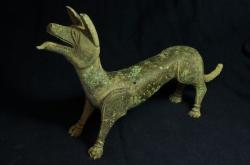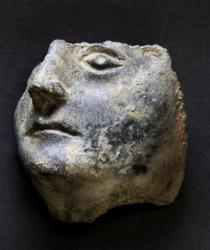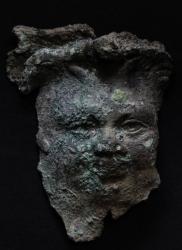INSTITUT SUPERIEUR D'ANTHROPOLOGIE
INSTITUTE OF ANTHROPOLOGY
ONLINE COURSES / COURS A DISTANCE
FALL TERM : OCTOBER 2017
REGISTER NOW
NORVEGE –  Efjorden - The petroglyph was discovered by retired geologist Ingvar Lindahl at Efjorden in the Nordland county, reports broadcaster NRK. Analysis has now estimated the petroglyph, which depicts a boat, to be between 10,000 and 11,000 years old, according to the report. The petroglyph was dated using estimates of the height of the water level against the rock on which it is carved, Gjerde said. Water levels in the region were higher during the Stone Age than they are today. “The boat is a little over four metres long. You can see the keel line and the railing line, and as you move forward you can see a really beautiful finish, forming the boat’s bows,” Gjerde told NRK, adding that the find was “incredibly exciting”.
Efjorden - The petroglyph was discovered by retired geologist Ingvar Lindahl at Efjorden in the Nordland county, reports broadcaster NRK. Analysis has now estimated the petroglyph, which depicts a boat, to be between 10,000 and 11,000 years old, according to the report. The petroglyph was dated using estimates of the height of the water level against the rock on which it is carved, Gjerde said. Water levels in the region were higher during the Stone Age than they are today. “The boat is a little over four metres long. You can see the keel line and the railing line, and as you move forward you can see a really beautiful finish, forming the boat’s bows,” Gjerde told NRK, adding that the find was “incredibly exciting”.
https://www.thelocal.no/20170927/discovery-of-10000-year-old-petroglyph-in-norway-described-as-sensational
USA –  Boston - An excavation at the site of Paul Revere’s home, which was built in Boston’s North End in 1711, has uncovered a four-foot-by-six-foot brick rectangle that may have served as a privy. “Typically what you would do is you would dig a big pit, you’d line it with bricks,” said city archaeologist Joe Bagley. “You typically would also line it with clay, because you didn’t want the contents to leach into your well.” The handle to an eighteenth-century German-made beer stein is the only item to have been found in the pit so far, but the outhouse could yield thousands of discarded artifacts, in addition to information on the health and diet of the Revere family.
Boston - An excavation at the site of Paul Revere’s home, which was built in Boston’s North End in 1711, has uncovered a four-foot-by-six-foot brick rectangle that may have served as a privy. “Typically what you would do is you would dig a big pit, you’d line it with bricks,” said city archaeologist Joe Bagley. “You typically would also line it with clay, because you didn’t want the contents to leach into your well.” The handle to an eighteenth-century German-made beer stein is the only item to have been found in the pit so far, but the outhouse could yield thousands of discarded artifacts, in addition to information on the health and diet of the Revere family.
VIDEO - http://boston.cbslocal.com/2017/09/26/paul-revere-outhouse-north-end-house-dig-joe-bagley/
INDE - Bogalur - A team of local amateur archaeologists has discovered celt and other artefacts, said to belong to Megalithic age and Sangam period, at Bogalur near here. The team of archaeologists of Ramanathapuram Archaeological Research Foundation, led by its president V. Rajaguru, found the artefacts near the Mullaikottai Muneeswarar Temple on the banks of Kaathan odai. “This is the first new stone age artefacts discovered in the district and the findings clearly indicated that neolithic or new stone age people led a settled life in the area till the Sangam age,” Mr. Rajaguru told The Hindu. After schoolteachers Gandhi and Bhoominathan informed about potsherds strewn in an area of 40 acres near the temple, he, along with association secretary Gnanakalimuthu and research scholar Hari Gopalakrishnan, conducted an exploration and found the celt and other artefacts. The stone celt measured 7 cm in length and 5.5 cm in width, he said, adding it was also found well-polished and sharpened. The tool had some holes in the upper portion and this could be due to long use. The tool would have been used with a wooden handle, he added. The team also found a grinding stone, sling stone, graffiti marked potsherds, pot stand, black and red potsherds, spindle whorls, hopscotches, broken part of terracotta kettle, terracotta handle, piece of deer horn, iron ore and iron slags. The iron-based artefacts indicated that megalithic age people also lived in the area, he said. A black and red potsherd had the graffiti of Tamil Brahmi letter and another had trident graffiti and these artefacts could be 2,000 years old and belong to the Sangam period, he said. The sling stone was in use since new stone age and it was used for hunting as well as safety, he said. A lush green Miswak, a medicinal plant native to Palai, one of the five landscapes of Sangam period, was found in the area. He suggested that it was an ideal location for exaction by the Archaeological Survey of India or the State Department of Archaeology, he said.
http://www.thehindu.com/news/national/tamil-nadu/artefacts-of-historical-interest-unearthed-in-ramnad/article19758037.ece
IRAN –  Hegmataneh - The Public Relations Office of the Research Institute of Cultural Heritage and Tourism (RICHT) quoted Mohammad Rahim Ranjbaran, head of the exploration team recently as saying the purpose of the current exploration operations (documentation of the fortress of Hegmataneh), is to revitalize and organize the main lines and structure of the fortifications of Hegmataneh. The passage of decades since the previous explorations and under the influence of atmospheric factors and inadequate protection widespread and serious damage has been inflicted on the remains of the structures, he added. Meanwhile, Ranjbaran noted, documentation, investigation of the quality and nature and the geometry of the fortress is the first and basic step for conducting any protective study in future. The first archaeological measure in Hegmataneh dates back to one century ago which was conducted by the French Charles Fossey who had been assigned by the Louvre Museum, he said. Ranjbaran pointed to the archaeological achievements in Hegmataneh, and noted that constant excavations in the area have led to the identification of remains of outstanding archeological architecture of an ancient city which is mainly built with adobe material in 40x40x16 in accordance with a specific plan and pattern. The ancient Hegmataneh area with a span of approximately 35 hectares is located in the old and central texture of the city of Hamedan and is among the first monuments which was included in the list of the National Monuments under No. 28 in the year 1310 (1931) as the capital of the Medes. Based on the descriptions of the Greek historian Herodotus in the 5th century, Hegmataneh was the first capital of Persia and the Medes which was established by the founder of the dynasty Diaoco with massive and labyrinth walls, each in different colors. He stated that writings remaining from the Greek historians and geographers leave no doubt about the location of Hegmataneh in the slopes of the Alvand Mountain and its present position and also the research and archeologists who have visited the present Hegmataneh in the past two centuries and the studies conducted in this regard almost all have the consensus that the remains belong to the Medes Hegmataneh.
Hegmataneh - The Public Relations Office of the Research Institute of Cultural Heritage and Tourism (RICHT) quoted Mohammad Rahim Ranjbaran, head of the exploration team recently as saying the purpose of the current exploration operations (documentation of the fortress of Hegmataneh), is to revitalize and organize the main lines and structure of the fortifications of Hegmataneh. The passage of decades since the previous explorations and under the influence of atmospheric factors and inadequate protection widespread and serious damage has been inflicted on the remains of the structures, he added. Meanwhile, Ranjbaran noted, documentation, investigation of the quality and nature and the geometry of the fortress is the first and basic step for conducting any protective study in future. The first archaeological measure in Hegmataneh dates back to one century ago which was conducted by the French Charles Fossey who had been assigned by the Louvre Museum, he said. Ranjbaran pointed to the archaeological achievements in Hegmataneh, and noted that constant excavations in the area have led to the identification of remains of outstanding archeological architecture of an ancient city which is mainly built with adobe material in 40x40x16 in accordance with a specific plan and pattern. The ancient Hegmataneh area with a span of approximately 35 hectares is located in the old and central texture of the city of Hamedan and is among the first monuments which was included in the list of the National Monuments under No. 28 in the year 1310 (1931) as the capital of the Medes. Based on the descriptions of the Greek historian Herodotus in the 5th century, Hegmataneh was the first capital of Persia and the Medes which was established by the founder of the dynasty Diaoco with massive and labyrinth walls, each in different colors. He stated that writings remaining from the Greek historians and geographers leave no doubt about the location of Hegmataneh in the slopes of the Alvand Mountain and its present position and also the research and archeologists who have visited the present Hegmataneh in the past two centuries and the studies conducted in this regard almost all have the consensus that the remains belong to the Medes Hegmataneh.
http://www.irna.ir/en/News/82679593
ROYAUME UNI – 

 – Gloucestershire - A hoard of ancient Roman bronze artefacts discovered in Gloucestershire includes a unique sculpture of a ‘licking’ dog, never found before in Britain – and archaeologists have a fascinating theory about its origins and why it was hidden. The discovery was made by a metal detectorist who contacted the archaeology team.The licking dog is an example of a healing statue, and may be linked to the Roman healing temple at Lydney. However there is also the possibility that a previously undiscovered Roman temple may be sited elsewhere in Gloucestershire, experts said. The artefacts appear to have been deliberately broken and hidden – with the exception of the dog statue, which remains intact. The exact location of where they were found has not been revealed. Archaeologists believe the items could have been stashed by a metal worker who intended to retrieve them at a later date in order to melt and re-cast them.
– Gloucestershire - A hoard of ancient Roman bronze artefacts discovered in Gloucestershire includes a unique sculpture of a ‘licking’ dog, never found before in Britain – and archaeologists have a fascinating theory about its origins and why it was hidden. The discovery was made by a metal detectorist who contacted the archaeology team.The licking dog is an example of a healing statue, and may be linked to the Roman healing temple at Lydney. However there is also the possibility that a previously undiscovered Roman temple may be sited elsewhere in Gloucestershire, experts said. The artefacts appear to have been deliberately broken and hidden – with the exception of the dog statue, which remains intact. The exact location of where they were found has not been revealed. Archaeologists believe the items could have been stashed by a metal worker who intended to retrieve them at a later date in order to melt and re-cast them.
http://www.gloucestershirelive.co.uk/news/gloucester-news/amazing-discovery-could-evidence-hidden-542056
FINLANDE –  Loppi - A remarkably well-preserved Viking-era sword has been found in a previously-unknown level-ground cremation cemetery in Loppi, southern Finland. The find was made last spring by the landowner, an amateur history buff, using a metal detector. According to Dr. Anna Wessman, an archaeologist at the University of Helsinki and the University of Chester, level-ground cremation cemeteries, also known as flat cremation cemeteries, were used in the late Migration and Viking periods in Finland, Estonia, Latvia and Russia’s Karelian Isthmus. She notes that weapons were often scattered among the stones and ashes in these shallow burial sites, but that they were usually “deliberately broken either before or after being laid on the pyre. The same custom is also known from Sweden and Estonia.”The Board of Antiquities carried out a dig at the site in late August and early September. It says the cremation cemetery and the sword date back to the late Viking era, around the year 1000. Found next to the sword’s handle was a sheath containing a knife, a circular brooch and a comb made of bone. Also found at the site was a fragile ash urn along with many burned bone fragments. A bit further away was the blade of a work axe.The bones will be carbon-dated to determine their exact age, and undergo other analysis that may reveal the gender of the person or persons buried at the site, and whether animals were burned there. Soil samples, meanwhile, will be tested for clues such as which time of year the burial occurred.
Loppi - A remarkably well-preserved Viking-era sword has been found in a previously-unknown level-ground cremation cemetery in Loppi, southern Finland. The find was made last spring by the landowner, an amateur history buff, using a metal detector. According to Dr. Anna Wessman, an archaeologist at the University of Helsinki and the University of Chester, level-ground cremation cemeteries, also known as flat cremation cemeteries, were used in the late Migration and Viking periods in Finland, Estonia, Latvia and Russia’s Karelian Isthmus. She notes that weapons were often scattered among the stones and ashes in these shallow burial sites, but that they were usually “deliberately broken either before or after being laid on the pyre. The same custom is also known from Sweden and Estonia.”The Board of Antiquities carried out a dig at the site in late August and early September. It says the cremation cemetery and the sword date back to the late Viking era, around the year 1000. Found next to the sword’s handle was a sheath containing a knife, a circular brooch and a comb made of bone. Also found at the site was a fragile ash urn along with many burned bone fragments. A bit further away was the blade of a work axe.The bones will be carbon-dated to determine their exact age, and undergo other analysis that may reveal the gender of the person or persons buried at the site, and whether animals were burned there. Soil samples, meanwhile, will be tested for clues such as which time of year the burial occurred.
https://yle.fi/uutiset/osasto/news/finnish_history_buff_finds_viking-era_sword_on_lake_shore/9854392
INDE - Hyderabad - Historians from the city have found ancient structures of Palaeolithic age at the site of one of the highest waterfalls in the forest area of Jayashankar Bhupalapally district. The site is close to Charla which has not been much explored due to Maoist presence. Historian Dyavanapalli Satyanarayana, who visited the Gaddalasari waterfall in deep forests of Charla-Venkatapur in the borders of Chattisgarh, says that the waterfall will be about 700 feet in height ."The waterfall is named Gaddalasari as eagles fly high on it. It could be one of the highest waterfalls on par with those in Meghalaya and Karnataka. The waterfall area was a shelter to prehistoric people thousands and thousands of years ago.Based on the stone tools (pebbles, fakes and blades), they belong to three successive ages - Lower Palaeolithic, Middle Palaeolithic and Upper Palaeolithic. Prehistoric people lived there right from at least 11.25 lakh years to 20,000 years BC. These dates are estimated by collaborating the evidence found here with the evidence found and interpreted by archaeologist Thakur Raja Ram Singh," said D Satyanarayana.
Hyderabad - Historians from the city have found ancient structures of Palaeolithic age at the site of one of the highest waterfalls in the forest area of Jayashankar Bhupalapally district. The site is close to Charla which has not been much explored due to Maoist presence. Historian Dyavanapalli Satyanarayana, who visited the Gaddalasari waterfall in deep forests of Charla-Venkatapur in the borders of Chattisgarh, says that the waterfall will be about 700 feet in height ."The waterfall is named Gaddalasari as eagles fly high on it. It could be one of the highest waterfalls on par with those in Meghalaya and Karnataka. The waterfall area was a shelter to prehistoric people thousands and thousands of years ago.Based on the stone tools (pebbles, fakes and blades), they belong to three successive ages - Lower Palaeolithic, Middle Palaeolithic and Upper Palaeolithic. Prehistoric people lived there right from at least 11.25 lakh years to 20,000 years BC. These dates are estimated by collaborating the evidence found here with the evidence found and interpreted by archaeologist Thakur Raja Ram Singh," said D Satyanarayana.
http://timesofindia.indiatimes.com/city/hyderabad/ancient-structures-stone-age-tools-found/articleshow/60849561.cms